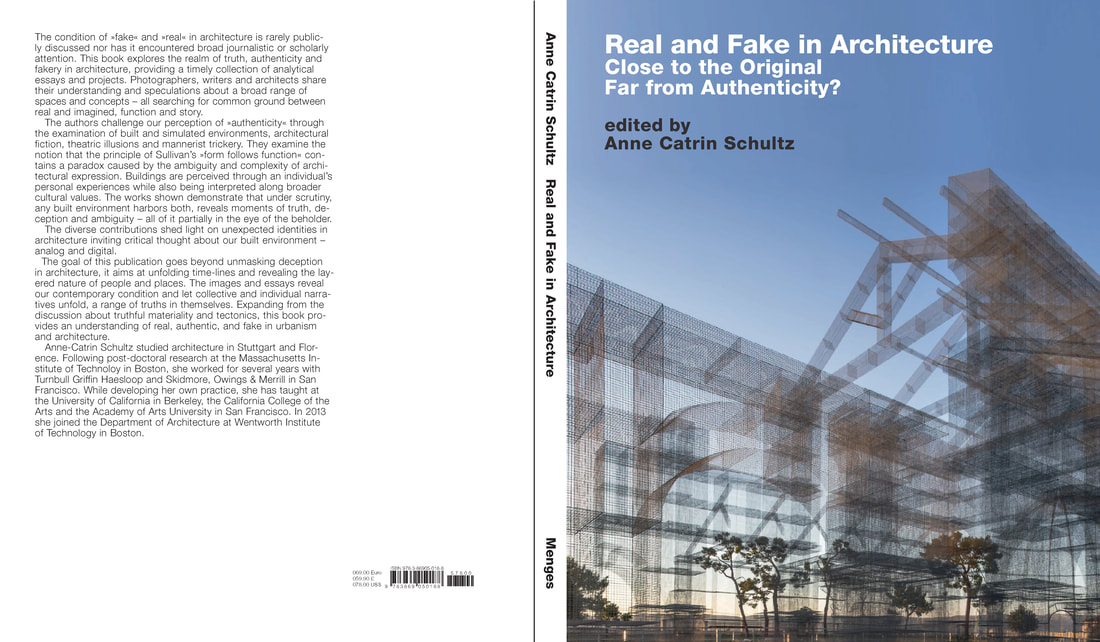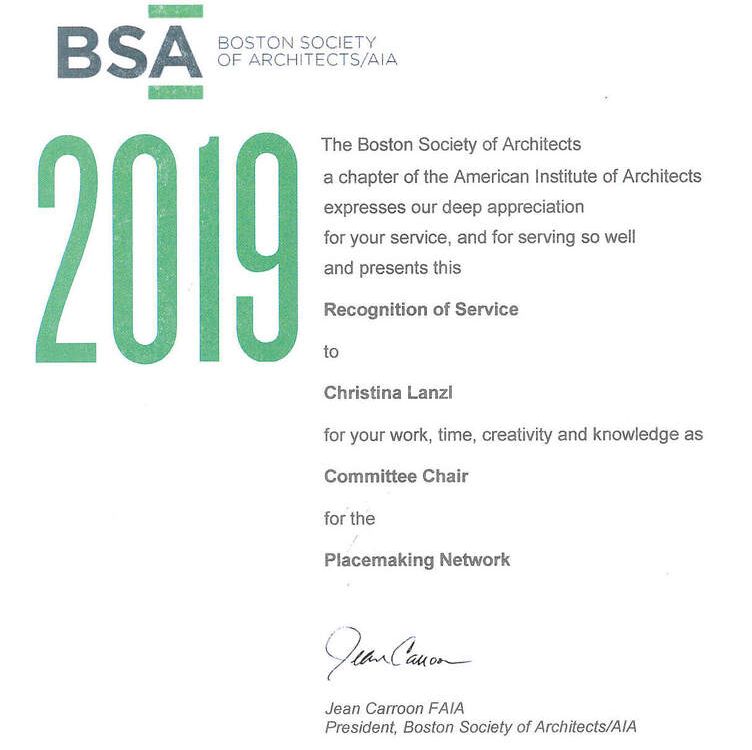| Design Innovation in Architecture: The Spatial Augmented Realities of UrbanScreen Essay by Christina Lanzl Edition Menges has published a new anthology by Anne-Catrin Schultz, Associate Professor of the Department of Architecture at Wentworth Institute of Technology. Through her research she realized that the condition of »fake« and »real« in architecture is rarely publicly discussed nor has it encountered broad journalistic or scholarly attention. This book explores the realm of truth, authenticity and fakery in architecture, providing a timely collection of analytical essays and projects. The authors challenge our perception of »authenticity« through the examination of built and simulated environments, architectural fiction, theatric illusions and mannerist trickery. Expanding from the discussion about truthful materiality and tectonics, this book provides an understanding of real, authentic, and fake in urbanism and architecture. The diverse contributions shed light on unexpected identities in architecture inviting critical thought about our built environment–analog and digital. Editor Anne-Catrin Schultz invited colleagues and friends to contribute essays: Dan Hisel, Morgan McMahon, Nicole Lambrou, Christina Lanzl, Eric Lum, Jennifer Lee Michaliszyn, Tom van Arman, Justin Vigilanti and Kemo Usto. Featured also are projects by Rima Abousleiman, Stefan Al, Alun Be, Kelly Hutzell and Rami el Samahy, Mat Maggio, Jessica Ronayne, Gregor Sailer, Allen Spore and Edoardo Tresoldi. The authors challenge our perception of »authenticity« through the examination of built and simulated environments, architectural fiction, theatric illusions and mannerist trickery. They examine the notion that the principle of Sullivan’s »form follows function« contains a paradox caused by the ambiguity and complexity of architectural expression. Buildings are perceived through an individual’s personal experiences while also being interpreted along broader cultural values. The works shown demonstrate that under scrutiny, any built environment harbors both, reveals moments of truth, deception and ambiguity – all of it partially in the eye of the beholder. The goal of this publication goes beyond unmasking deception in architecture, it aims at unfolding time-lines and revealing the layered nature of people and places. The images and essays reveal our contemporary condition and let collective and individual narratives unfold, a range of truths in themselves. Expanding from the discussion about truthful materiality and tectonics, this book provides an understanding of real, authentic, and fake in urbanism and architecture. Publication: Anne-Catrin Schultz (editor). Fake and Real in Architecture: Close To The Original, Far From Authenticity? Stuttgart: Edition Menges, 2020: 131-140. | Design Innovation in Architecture: The Spatial Augmented Realities of UrbanScreen Abstract | Essay by Christina Lanzl Design innovation in architecture frequently is the result of a continual, thoughtful consideration of human habitation, its evolution, research and experimentation. The innovation of materials in architecture and design is tested at a smaller scale, where experimentation can happen on modest budgets, in the incubator atmosphere of a workshop environment. Artistic applications and the internet, exhibitions and temporary installations or tradeshows serve as a platform to introduce new ideas, materials or groundbreaking scientific research to a public audience for the first time. At a large scale the intersection of research and innovation increasingly occurs in virtual environments, where ideas can be visualized without the pressure to invest in construction. This phase of theoretical application usually precedes prototyping or, at times, it may occur simultaneously. A most promising new technology with potential for development of neoteric applications for building façades is projection mapping, a process that maps projected light on the surface of any 3D form. The types of “fake” architectural façades (skins) thus created offer an opportunity for innovation in architectural design and permanent construction. Projection mapping is a burgeoning field. Therefore, this essay is limited to a case study approach. Particularly noteworthy are the architecturally inspired, “fake” designs by UrbanScreen, a cutting-edge practice based in Bremen, Germany since 2005. UrbanScreen creates cataclysmic possibilities of architectural design as spatial augmented realities that are projected onto iconic buildings. Opera Sydney in Australia, Romania’s Palace of Parliament in Bucharest, Houston’s Rice University, the Leopold Museum in Vienna/Austria and Kunsthalle Hamburg in Germany have staged dazzlingly symphonic and imaginative choreographies developed by the firm. The development of a generally poetic and magical theme on each of these buildings offers fertile ground for exploration. UrbanScreen concepts offer innovative visions for kinetic façade design leading to a series of relevant analytical questions. Which bright ideas may architectural designers deduce from temporary visualizations? Can the production of projected visuals and motion design inform permanent applications or, may this already have occurred? What kind of questions may arise concerning the digital interface and software codes when converting a projected to a static design? Can the visual drama and theatricality of a night-time projection that also features mesmerizing music and sound components be transformed into the design of a building envelope? This essay is intended to shed light onto these queries into fake architecture. |
|
2 Comments
Christina Lanzl Receives Recognition of Service Award from Boston Society of Architects/AIA1/31/2020 Christina Lanzl received a Recognition of Service award from the Boston Society of Architects/AIA for "work, time, creativity and knowledge as Committee Chair for the Placemaking Network", which she initiated as a platform for cross-disciplinary dialogue and exchange in 2007. The explicit vision of the Placemaking Network is to “investigate ways to enrich the public realm through dialogue among urban planning, landscape design, architecture, and public art/design professionals” as well as engaged citizens.
The initial Boston Society of Architects newsletter announcement started with the premise: “The topics of placemaking and quality of life have entered architecture and planning conversations as they have entered creative arts conversations.” Rather than simply functioning as a standing committee, the Placemaking Network had a mission to build a network of like-minded people who would introduce placemaking principles to their work and communities. By now, the network has grown to include engaged citizens and professionals of many backgrounds and disciplines. Since the beginning, concepts and case studies have been shared at monthly seminars where invited speakers present topics that are then discussed in a moderated roundtable format. The foundation of our work is that placemaking offers interdisciplinary dialogue on a successful public realm that engages communities and enriches lives. Initially, the spark of successful public places that are actively used or programmed by communities was ignited by proactive urbanists, whose publications honed in on the placemaking tenets. After ten years of experience and conversations, the Placemaking Manifesto took form. Christina Lanzl invited co-chair Robert Tullis and architectural historian Anne-Catrin Schultz to co-write a one-page policy that lists the core placemaking principles in six points. Using the equation symbol to summarize each value the document reads like a poem. Our draft was reviewed and confirmed by our network’s interdisciplinary ad hoc working group. Succinctly, we concluded that placemaking is about sense of place. Everybody––people of all backgrounds, ages and abilities––can participate in creating successful public places. Everyone can serve the agenda of excellence in design, healthy communities and thriving neighborhoods. We see our built environment as a common good that comes alive through an understanding of how humans instinctively relate to space, design leadership that leverages it, and activity programming that capitalizes on it. Over the years, my ongoing work in the field of public art and with the Placemaking Network has been a cross-fertilizer on how to best mark place, history and time through integrative, community-based public art and culture that furthers identity, local storytelling as well as learning. This story includes an excerpt from the essay "Toward a New Paradigm: Public Art and Placemaking in the 21st Century" by Christina Lanzl, published in Extraordinary Partnerships: How the Arts and Humanities are Transforming Society, edited by Christine Henseler (Lever Press, 2020). |
Urban Culture Institute
The Urban Culture Institute Archives
May 2021
Categories
All
|


 RSS Feed
RSS Feed